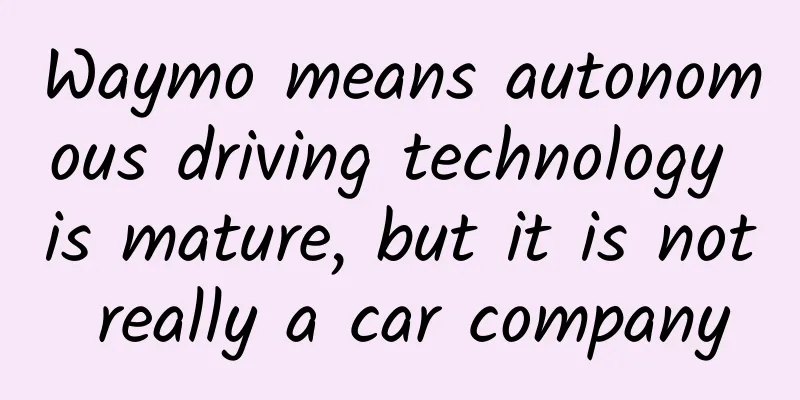Waymo means autonomous driving technology is mature, but it is not really a car company

|
Back in the 1960s, when Steve Mahan was a kid, his mother would wake him up in the morning and let him watch TV as the space agency prepared to explore Mercury. "We heard a lot about how it was going to be, the technical details, everything leading up to the launch," Mahan said. "And then we'd count down to zero, and then the ignition would start, and the rocket would spew flames and smoke and then go away. And then you'd think about putting people in a capsule and sending them up into space." Now 63 years old and blind, Mahan has become one of the "capsule explorers". In October 2015, Mahan got into Google's self-driving capsule prototype car and was the first public user to try it out on public roads. There was no steering wheel, no pedals, and no one was controlling it. Google engineers considered Mahan's 10-minute "trip" on a road in Austin, Texas, in a self-driving car to be a key milestone. Eight years later, with two million miles on the road, Google is spinning out its self-driving car unit from X, which specializes in moonshot projects like internet balloons and delivery drones. From now on, the self-driving business is run by a company called Waymo, which is an independent subsidiary of Alphabet. Independence means that it is time for the technology to go to market. Waymo CEO John Krafcik said: "We are a self-driving car company, and our mission is to make it safe, easy to operate, and able to carry people or other things around." What does that mean? There is no answer to this question. Krafcik talked about car sharing, trucking, logistics, and even providing personal cars to individual consumers. Pushing Waymo into the real world could be a move for Google to catch up. Google was once central to the self-driving conversation, leading the way with technology that was probably years ahead of most companies at the time. Lately, Google’s lead doesn’t seem so clear. Last year, Uber, Tesla, Baidu, Ford, and General Motors all announced plans to aggressively develop fully self-driving cars and bring them to market, with the timeframe extending from next year to 2021. Inside Google, the X division is under a lot of pressure to deliver on its promises. Many are skeptical. Many executives have abandoned the Google project, such as tech whiz Chris Urmson, who reportedly was unhappy with Krafcik’s leadership. As Uber and nuTonomy welcome passengers in self-driving cars in Pittsburgh and Singapore, the company's car team is silent on when and how Google's car technology will be commercialized. Reports say Google's car program has shrunk, which makes it look like Google's driverless cars are lagging behind. The creation of Waymo could put the robot car division back in the game, at least in the public eye. Let the blind ride Google has long promoted the idea that driverless cars can reduce fatalities and allow people who cannot drive to drive. The Boston Consulting Group released a report saying that the potential market size of driverless cars will reach $42 billion by 2025. Putting Steve Mahan in a car seems to be a show. At age 37, in 1990, Mahan began to lose his sight, primarily due to a rare genetic condition called microphthalmia. Within a few years, he lost the sight in one eye, and in 2004 he underwent laser treatment, but lost the other. Doctors were able to restore 10 percent of his vision, but that too was eventually lost. Mahan can no longer drive, and for the past decade he has relied on family, friends and public transportation to get from his suburban home in Morgan Hill, California. He said the loss of his independence hurt. There's a green "Go" button inside the Google capsule, and pressing it relieves the pain, at least for the moment. "I have a chance to be like myself again, to be like myself in the past, to be like myself in the past, and it makes me a whole person," Mahan said. Mahan has ridden in Google cars twice before. In 2012, he rode in a car accompanied by engineers and police, and once in 2014 in a closed parking lot. Last year in Austin, he rode alone for the first time. "This trip is a demonstration of our ability to turn this into a production-ready product that can be pushed into the real world," said Nathaniel Fairfield, a member of Waymo's planning, control and routing team. In early 2015, Fairfield thought they were getting closer: Cars drove for days at Google's test site without human intervention. On public roads, the car had traveled 1.2 million miles, pulling over when emergency vehicles passed. If it hit a squirrel, the car would brake to avoid it, and it could understand the sign language of police and construction workers. The car knew when to be polite and when to make a sound. In the following years, the team drove the fleet another 800,000 miles, optimizing various functions. Not only that, Google also let employees and guests take the car for 10,000 driving trips. “We’ve learned a lot from getting the technology to this stage and how much more work is required to bring cars to everyone, everywhere,” Fairfield said. Expansion and conquest Regardless of the performance of the technology, it takes a huge effort to jump from the experimental stage to the "anyone, anywhere" stage. Waymo needs to prove that its self-driving system can operate in any environment, and then enter the public and make everyone accept it. If Alphabet's new company is ready to let cars drive on a certain street, every inch of the street must be mapped, and data must be obtained and fed into the car to keep the map up to date. Not only that, Waymo also needs to reduce costs, especially the space mapping radar components of the car. The radar is placed on the roof like a KFC bucket, and costs tens of thousands of dollars. Google is making its own sensor hardware with the goal of reducing costs. Xavier Mosquet, head of the North American automotive department of Boston Consulting Group, said that the cost must be cost-effective, especially the hardware, and Google's hardware has had problems in the past. Manufacturing cars at a large scale and at a low cost may be the biggest challenge, and only a few companies in the world can do it. In May, Google partnered with Fiat Chrysler to install driverless technology in Pacifica minivans. The cooperation may bear more important fruits, or Google will come together with other manufacturing giants. If Waymo can solve all the problems and get approval from regulators, it will also have to build infrastructure to allow car sharing, including car allocation and route planning. Uber has a huge advantage in this regard. Within 5 years, users have taken 2 billion rides through the Uber system, and the time spent by drivers has been significantly reduced. Now users don't have to sit in the back of the car to pay. Jonathan Matus, CEO of mobile data analysis company Zendrive, believes that this is very important and must have the right software. Once you win, the next thing is to get passengers on board. Given the many challenges ahead, even by the best estimates, Waymo is only halfway there. It may take years to solve all the problems. Hopefully Steve Mahan can wait patiently. Why was Waymo founded? By separating Waymo from Google's X lab and turning it into a subsidiary of Alphabet, Waymo can speak more for itself and talk about Alphabet's autonomous driving vision. First, it suggests something that everyone already knows: self-driving cars have passed a tipping point. In 2009, when Google engineers first tinkered with self-driving cars, we thought it was a pipe dream, but now it's becoming more and more real. Almost every major automaker has announced plans to launch self-driving or semi-autonomous cars in the near future, and Alphabet, Google, and Waymo also want to be part of the revolution. In order to achieve its goals, Waymo needs to have its own corporate structure, its own full-time employees, its own funds, etc. Allowing Waymo to be independent shows that Alphabet is convinced that the project is mature and can grow on its own; it has expectations for Waymo and hopes that it will grow. In addition, independence also sets up firewalls for projects and prepares for failure. Google has launched and cut so many projects that it is hard to count them all. Google is willing to take risks, develop new products, and move forward. This is very similar to Tesla CEO Musk, who once said, "If you don't allow failure, then you are not innovative enough." However, failure can have a huge negative impact and it will hurt the company, especially Waymo. For example, although Google's software has traveled 1 million miles in road tests, there is still a small chance that it may crash. If it does crash, it will lead to lawsuits. Failure would also damage the company’s image. By separating Waymo from the Google brand, Alphabet can insulate its core business from potential risks. Waymo is not a car company In the field of self-driving cars, Google is indeed in a leading position, but Waymo is not a car company. In the future, Waymo will license and sell self-driving technology to automakers, and the company will also cooperate with other industries, such as car sharing, trucking, logistics, and public transportation companies, which need self-driving technology. In Krafcik's words: "We are an autonomous technology company... We know very well that we are not a car company, and there are a lot of misunderstandings about that. We are not in the business of making better cars, we are in the business of making better drivers." Waymo's focus is on software. Recently, Apple cut the scale of its car project and paid more attention to car operating systems rather than manufacturing cars. Waymo's direction is basically the same. If Waymo and Apple successfully execute their plans to license their technology to automakers, Tesla may lose its advantage in L5 autonomous driving technology. In simple terms, Autopilot is a bit like the iPhone of the automotive industry, because Musk controls both the car hardware and the car software. But on the other hand, Waymo is similar to the Android of self-driving cars, because every automaker can use Waymo technology to develop self-driving cars, just like mobile phone manufacturers use Android to develop mobile phones. If automakers come to Waymo and want to license its technology, and Waymo agrees without hesitation, Tesla could become the exclusive, high-end, elite self-driving car brand. Tesla's tight control over hardware and software could make its cars more attractive to buyers. As a winner of Toutiao's Qingyun Plan and Baijiahao's Bai+ Plan, the 2019 Baidu Digital Author of the Year, the Baijiahao's Most Popular Author in the Technology Field, the 2019 Sogou Technology and Culture Author, and the 2021 Baijiahao Quarterly Influential Creator, he has won many awards, including the 2013 Sohu Best Industry Media Person, the 2015 China New Media Entrepreneurship Competition Beijing Third Place, the 2015 Guangmang Experience Award, the 2015 China New Media Entrepreneurship Competition Finals Third Place, and the 2018 Baidu Dynamic Annual Powerful Celebrity. |
<<: It came too fast: Hyundai's US CEO was fired
>>: Foreign media: Apple's performance in 2016 was really not very good
Recommend
How much does it cost to develop the Yanbian Logistics Mini Program?
WeChat Mini Program is an application that users ...
The sudden appearance of a huge star and the astronomer who calmed the public opinion crisis
In December of the second year of the Jingde reig...
The tiny zebrafish uses 80% of its genes to benefit 100% of the people!
There is a group of cute little elves. When they ...
The anchor show will be held at GMGC2016. GMGC will "find anchors with tens of millions of annual salary" with you.
In 2015, the profession with the most news about ...
GNMT - Google's neural network translation system
1. Introduction In September 2016, Google release...
"Blue Fire Micro-Course Lecturer Practical Training Camp" You can easily teach and make money even if you are not a lecturer
Absolutely useful information, based on 3 years o...
Will humans be replaced by artificial intelligence? Machines cannot do this
Copyrighted images from the gallery, unauthorized...
Since Cross-Bridge Rice Noodles is so hot, do we not have to worry about parasites?
Boiling hot soup, rice noodles that look particul...
What are the little red spots that suddenly appear on your body? The last one is the liver's alarm!
People often report that small red spots appear o...
Kaikeba Smart Logistics—Order Delivery Planning [2,4]
Kaikeba Smart Logistics—Order Delivery Planning [...
From "thick soup" to "clear stream", zircon pushes the formation of fresh water forward by 800 million years?
Tuchong Creative Water is something that everyone...
What can personal mini programs do? What mini programs can individual developers create?
What can personal mini programs do? What mini pro...
One example tells you how to use product thinking to carry out fission activities?
Background: In the second half of the Internet , ...
Can tooth inflammation actually "damage" your heart? Huaxi doctors teach you 4 tips to protect your cardiovascular health
As the saying goes: Disease comes from the mouth ...
iPhone 6 can be instantly turned into a brick if stolen
Apple Inc won praise from New York lawmakers for ...









